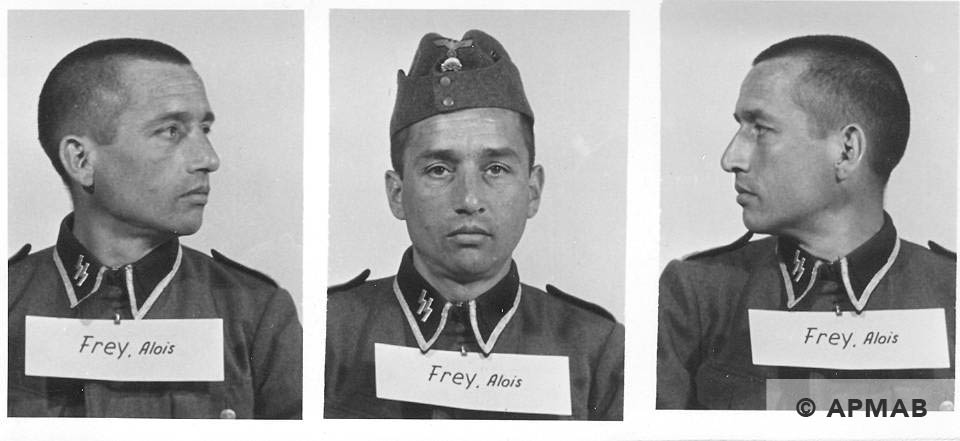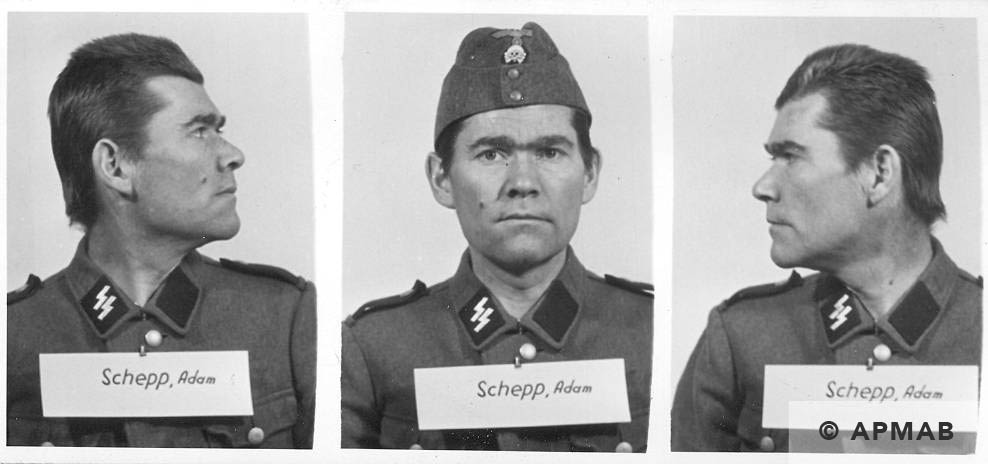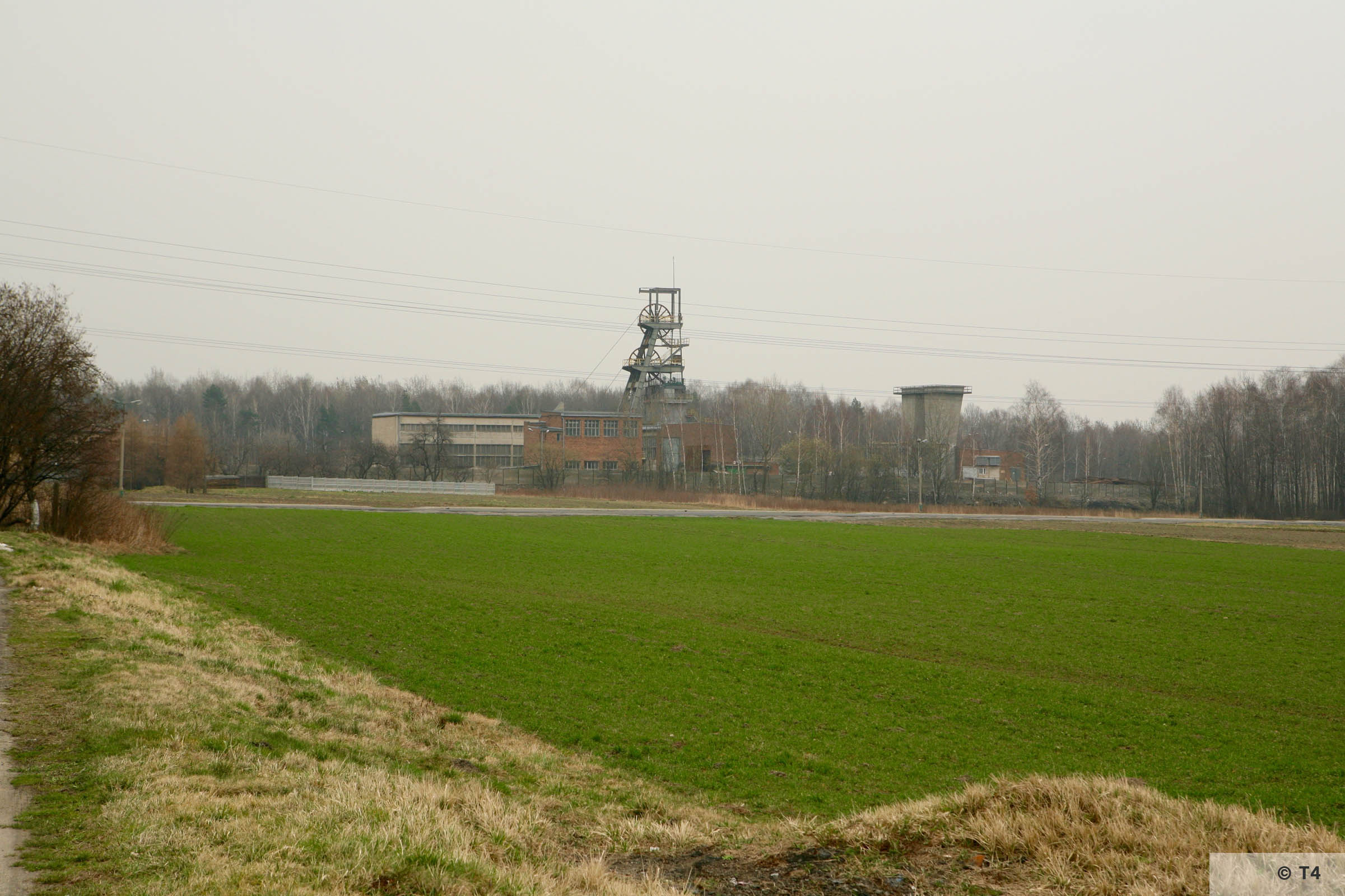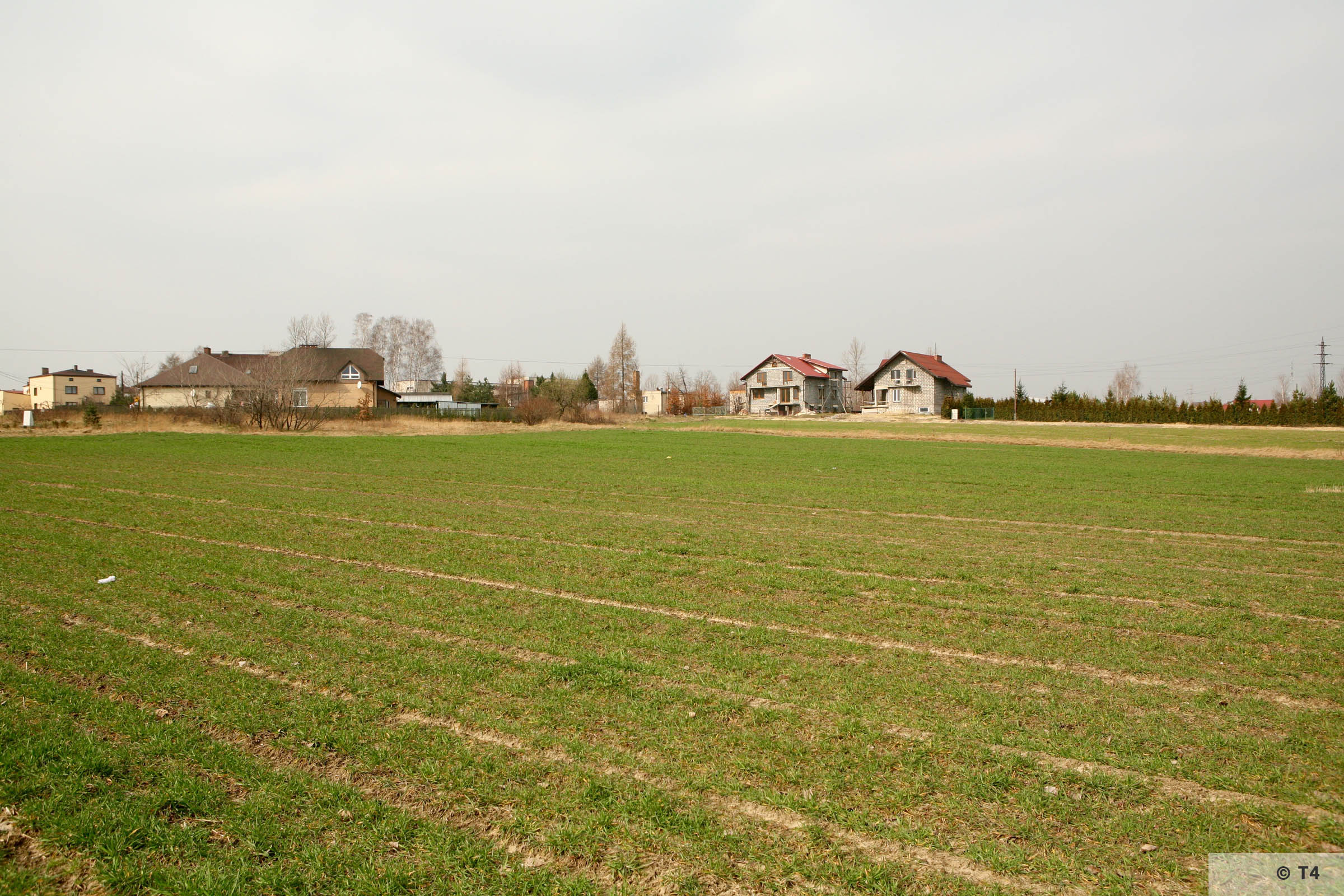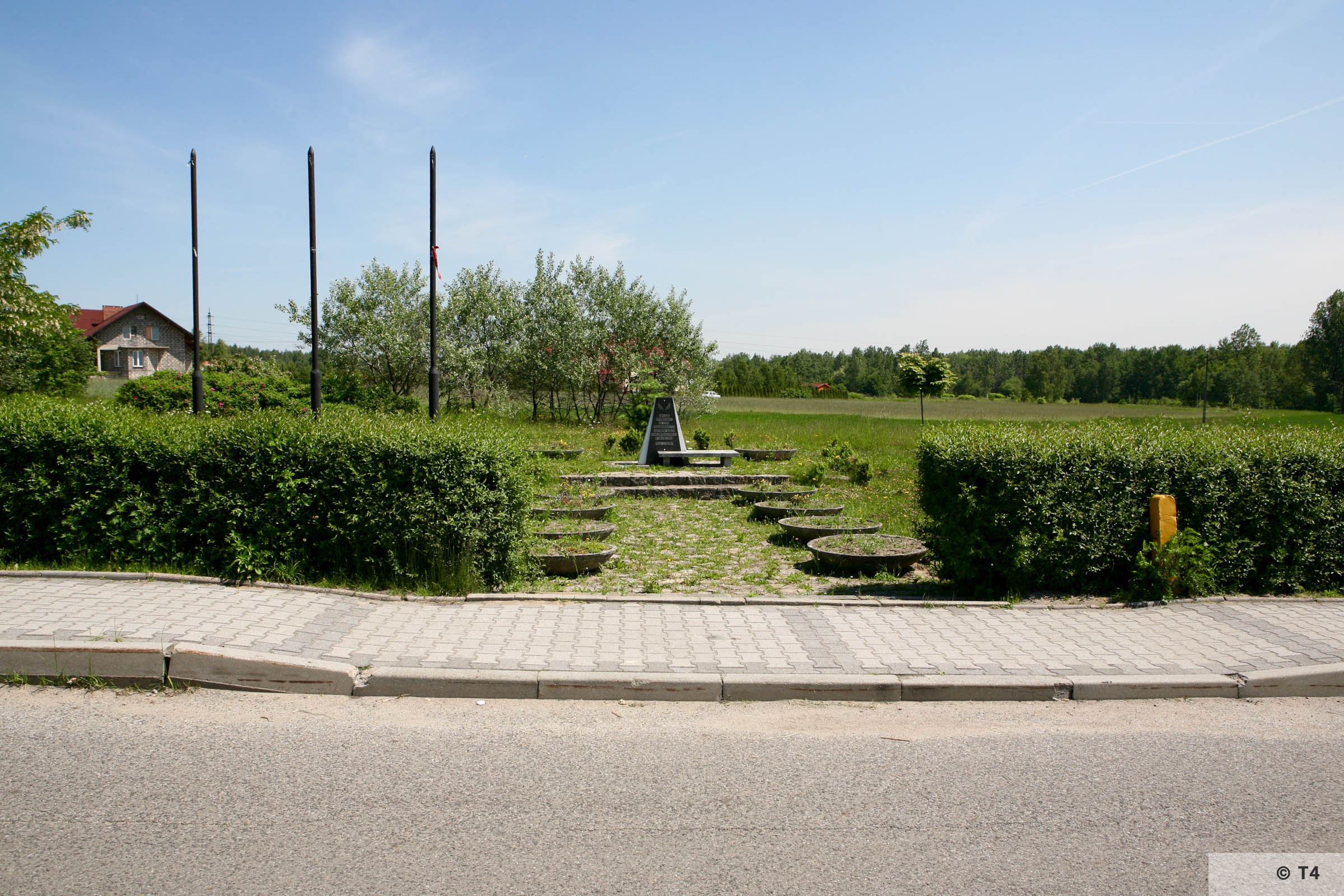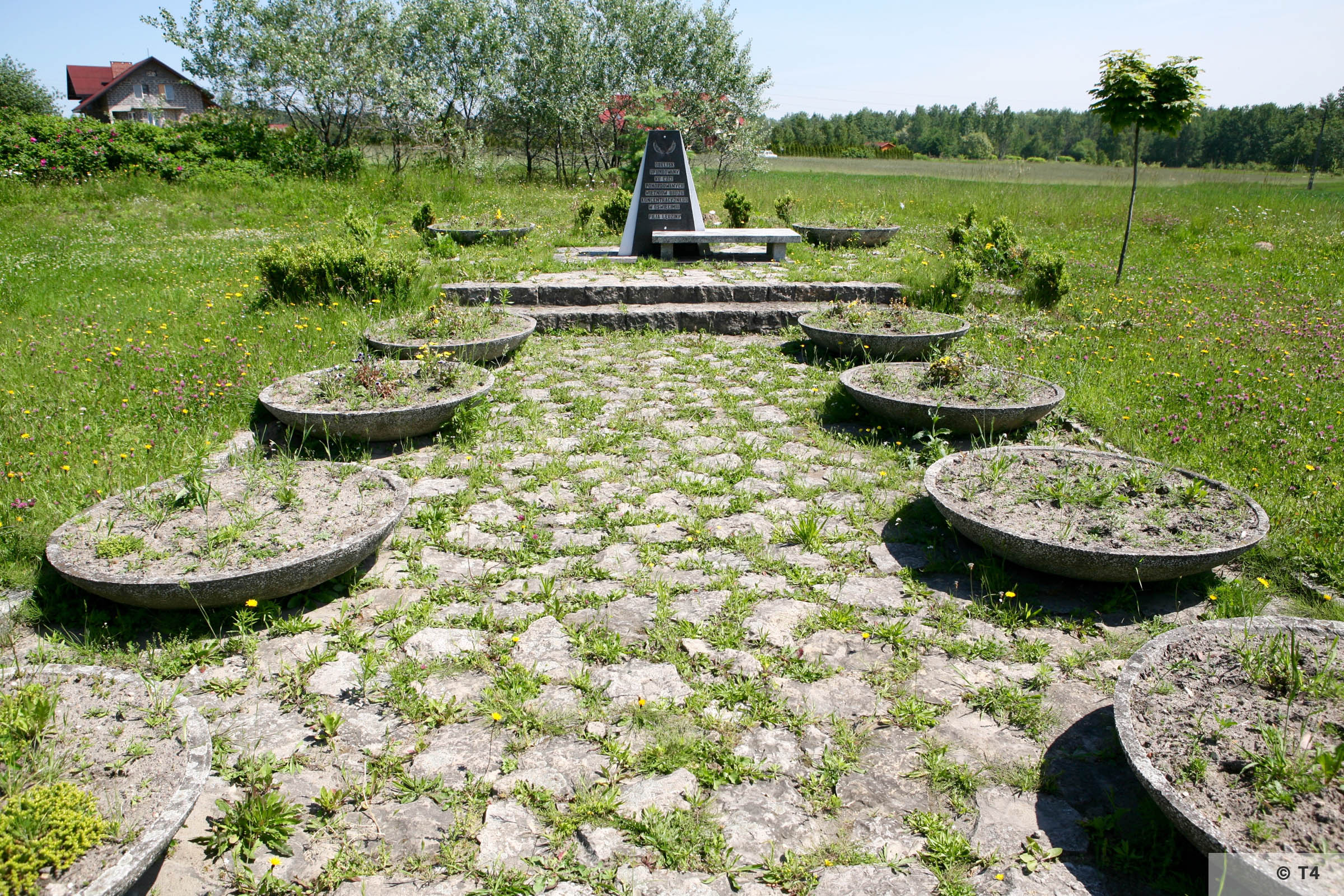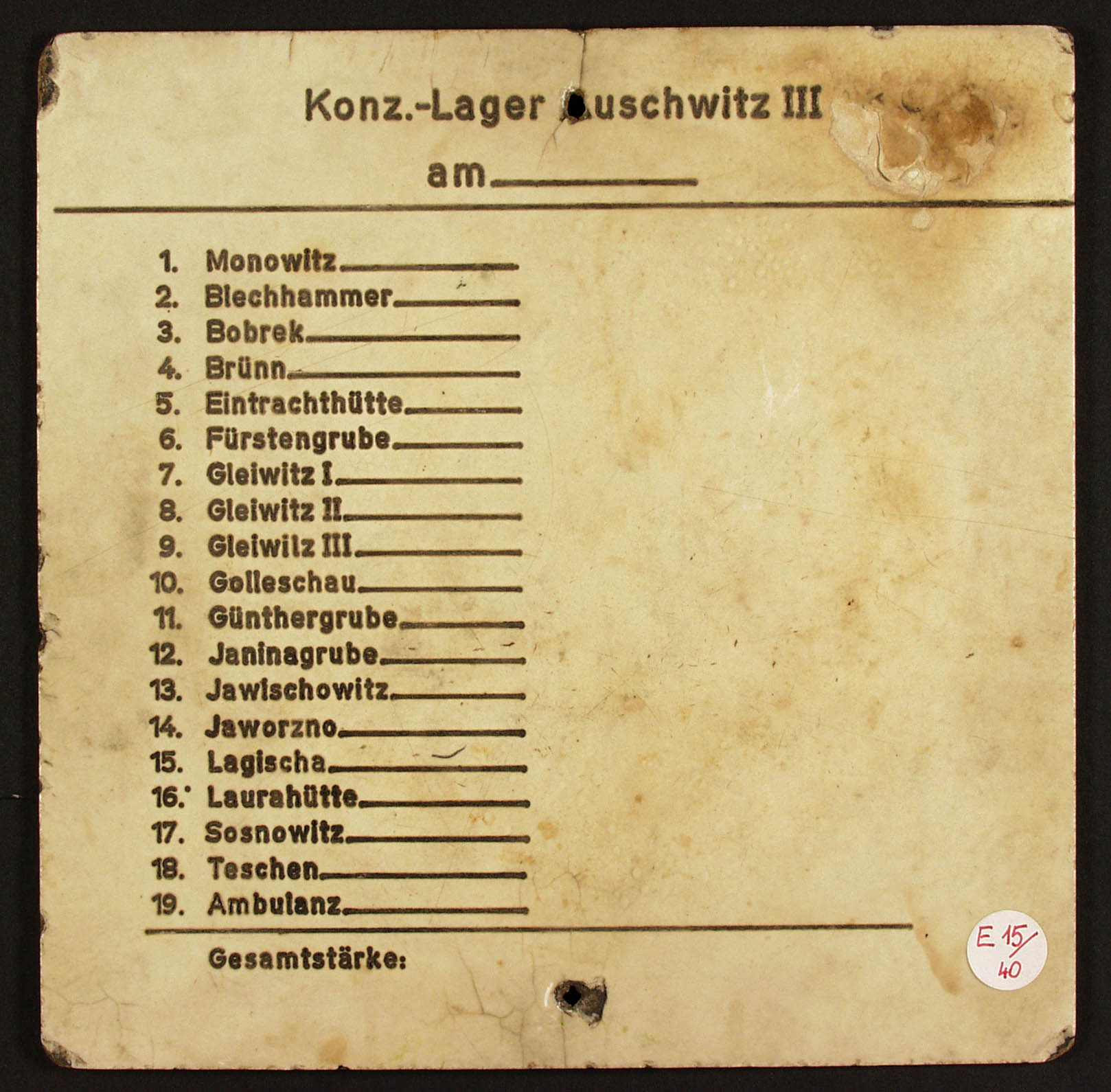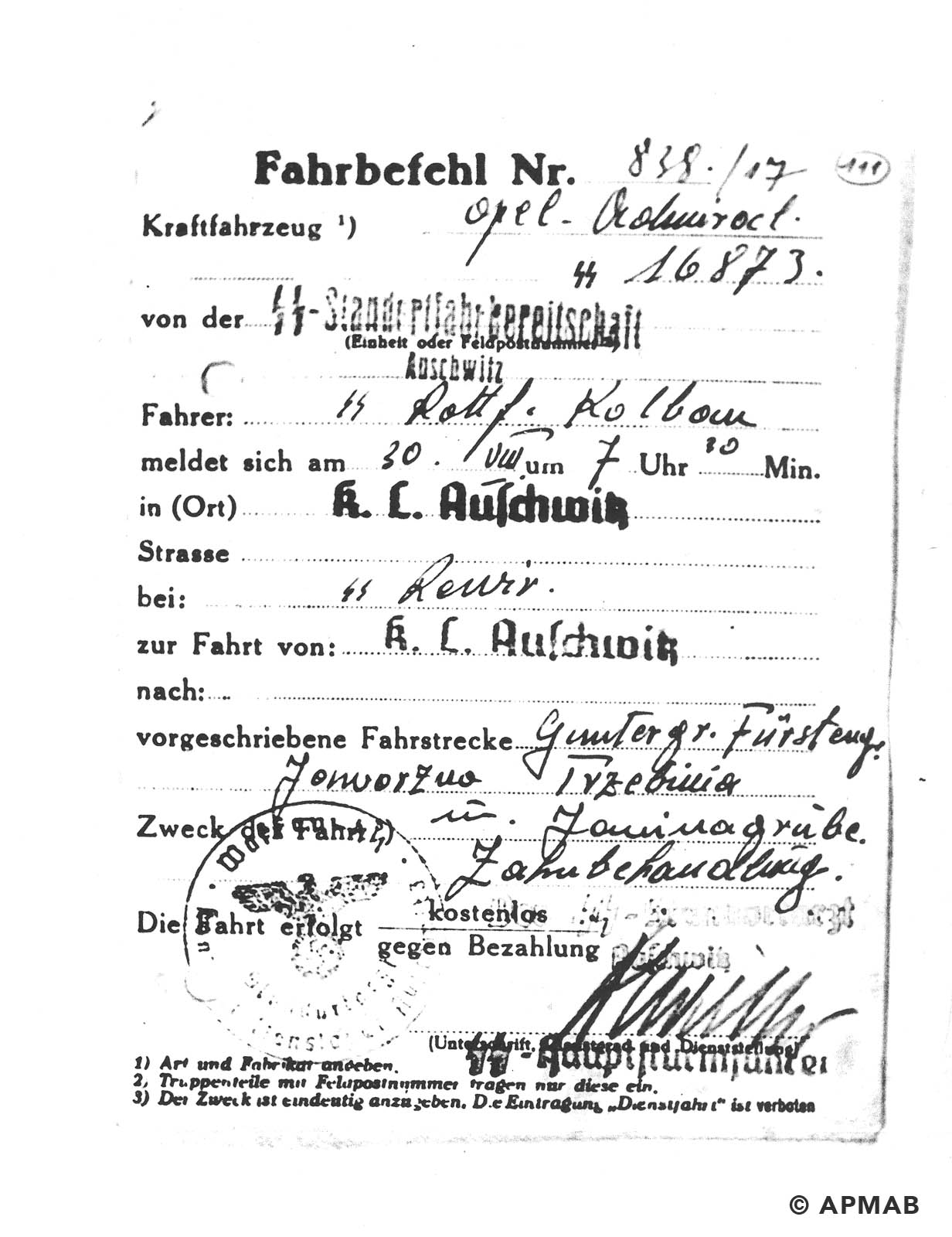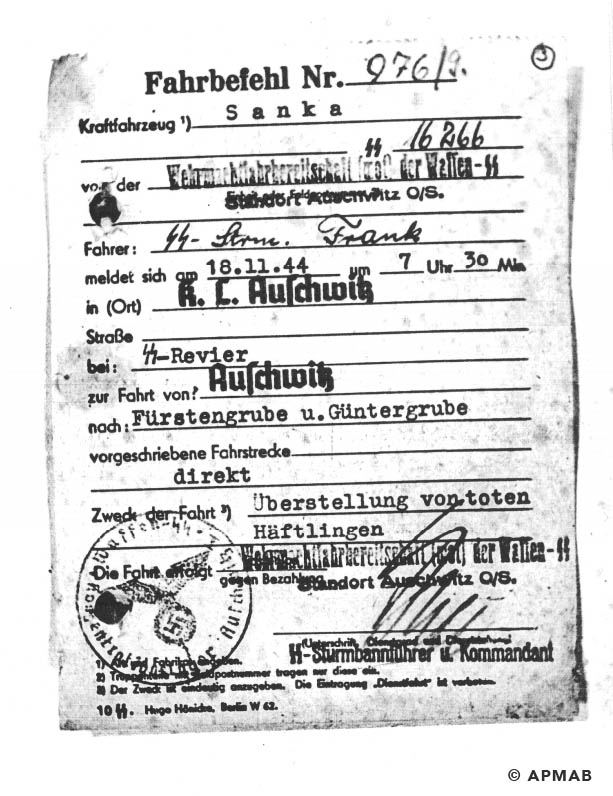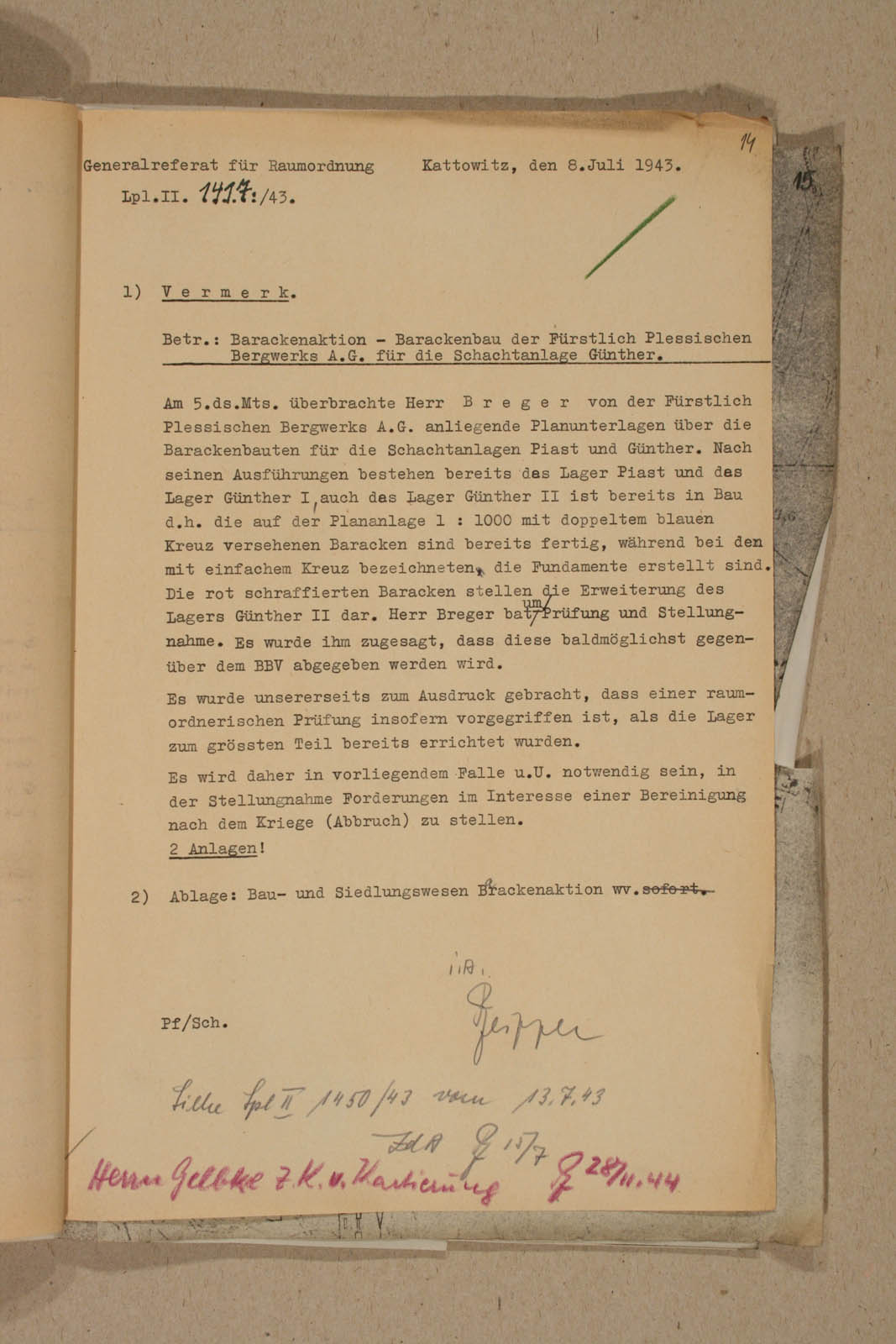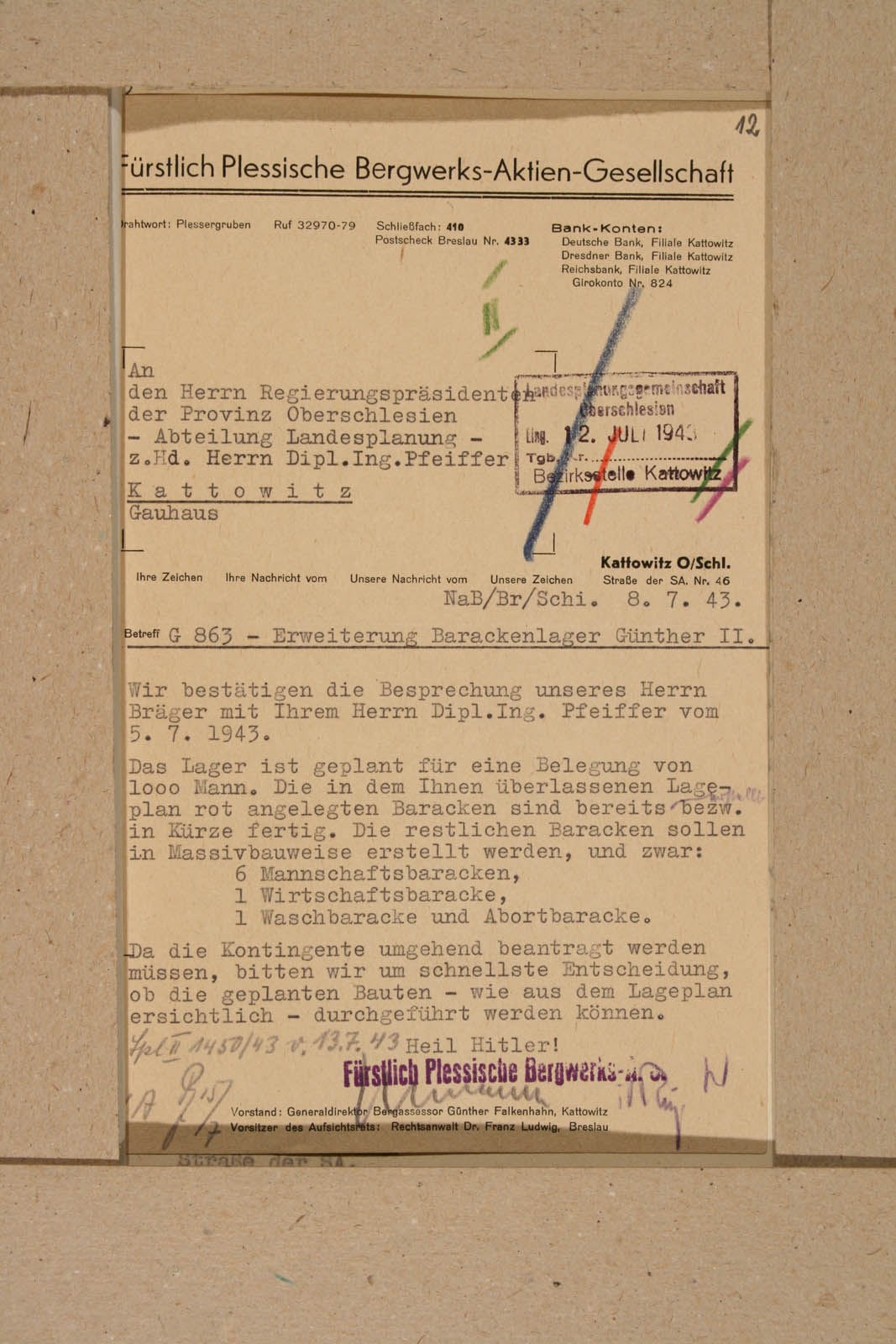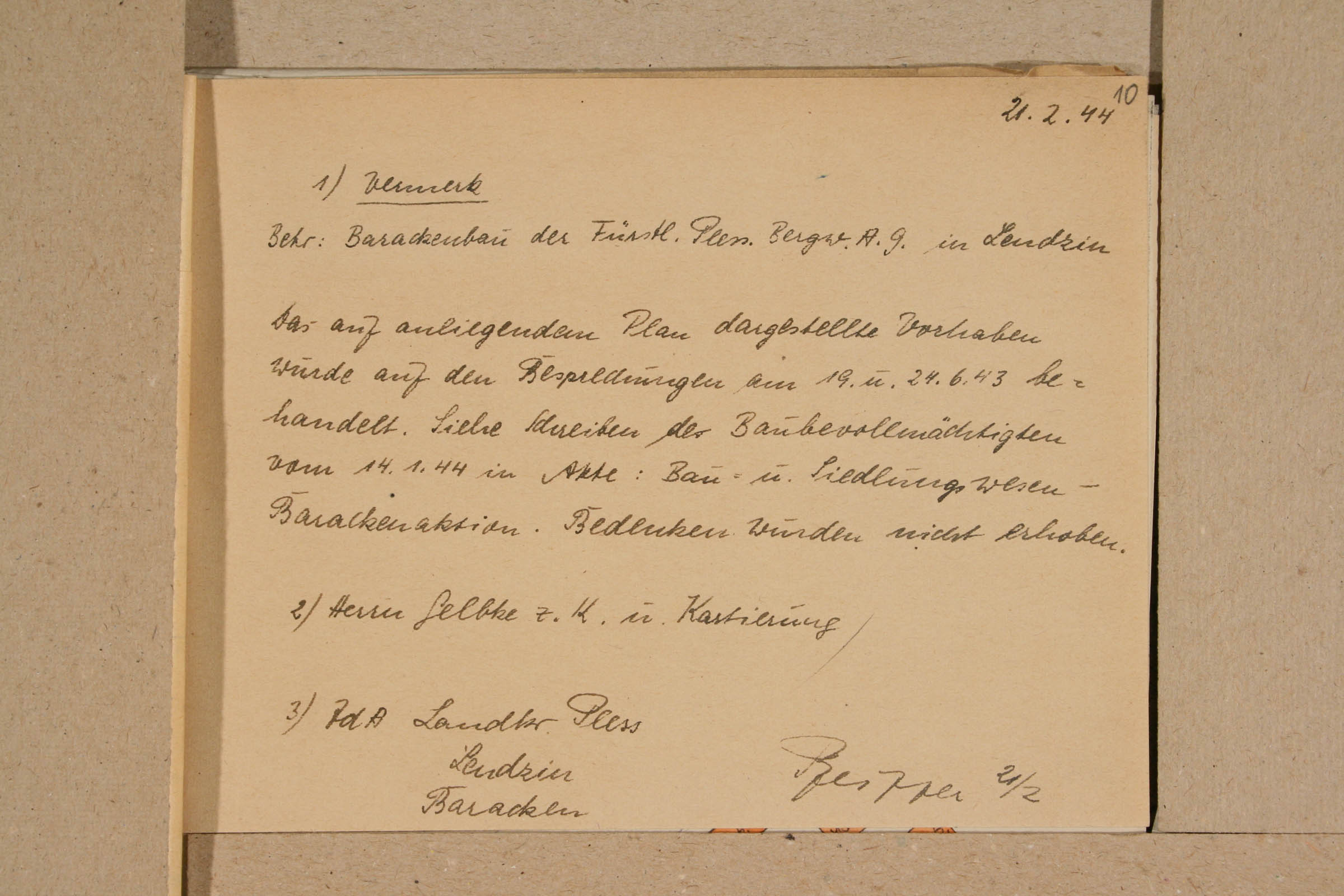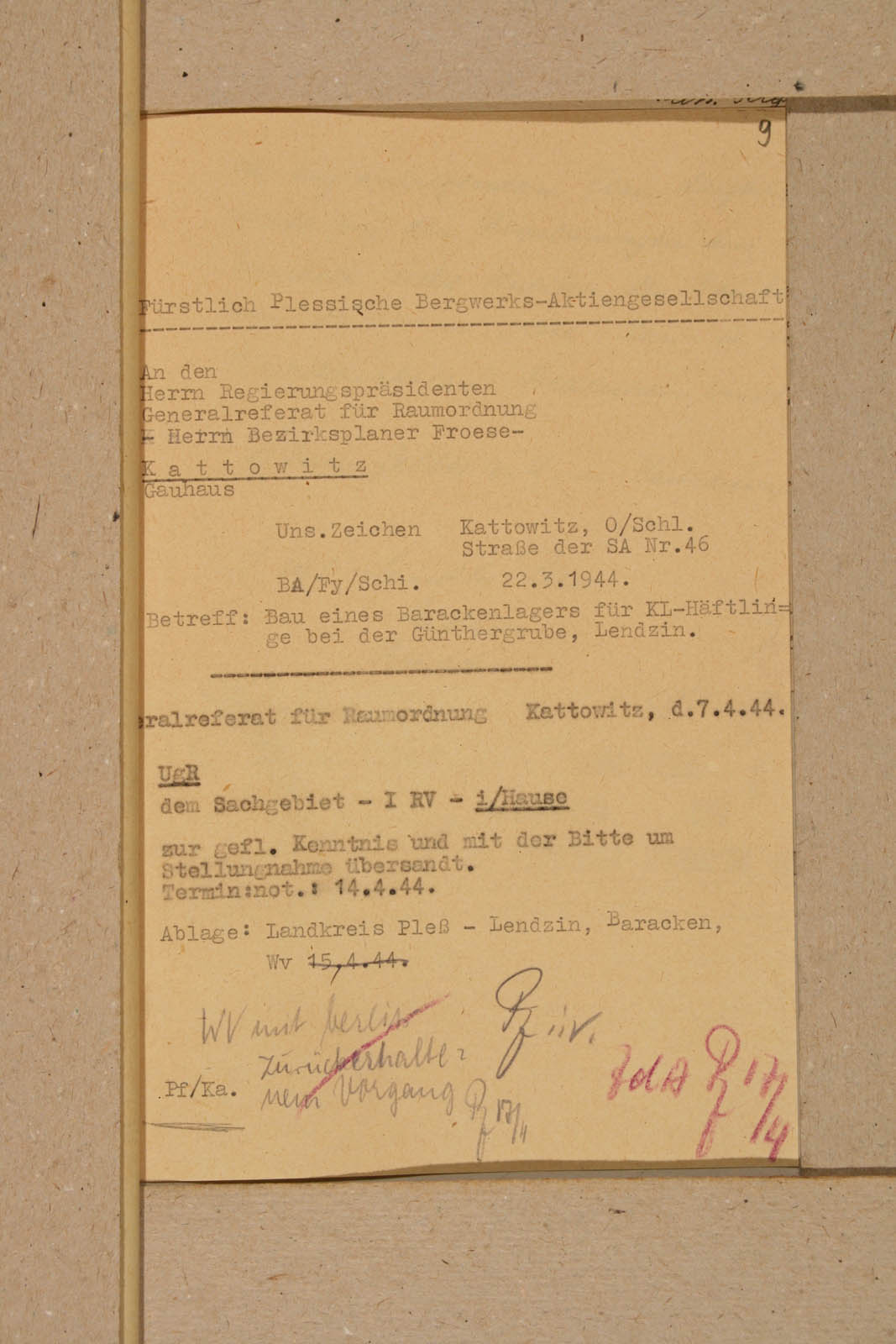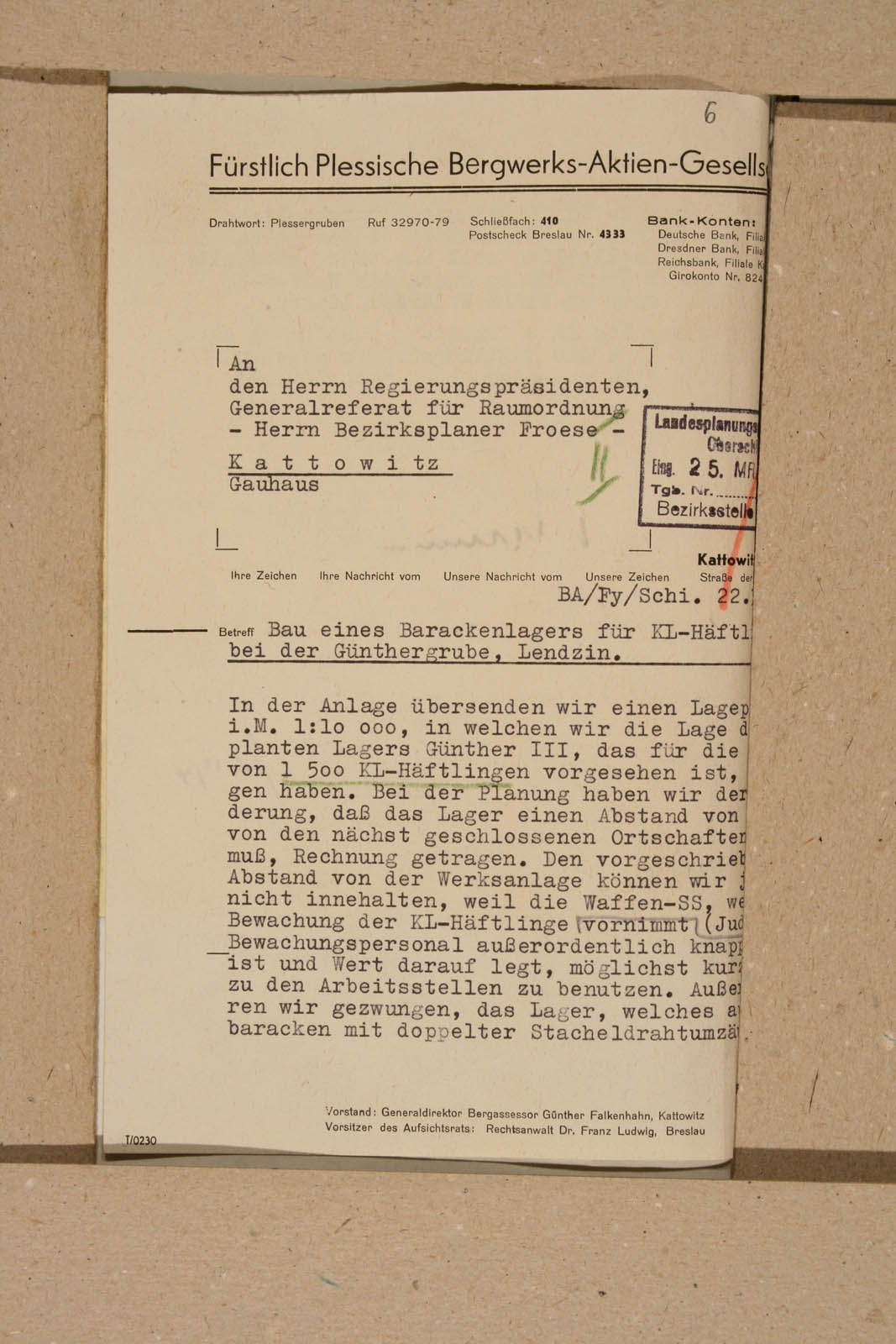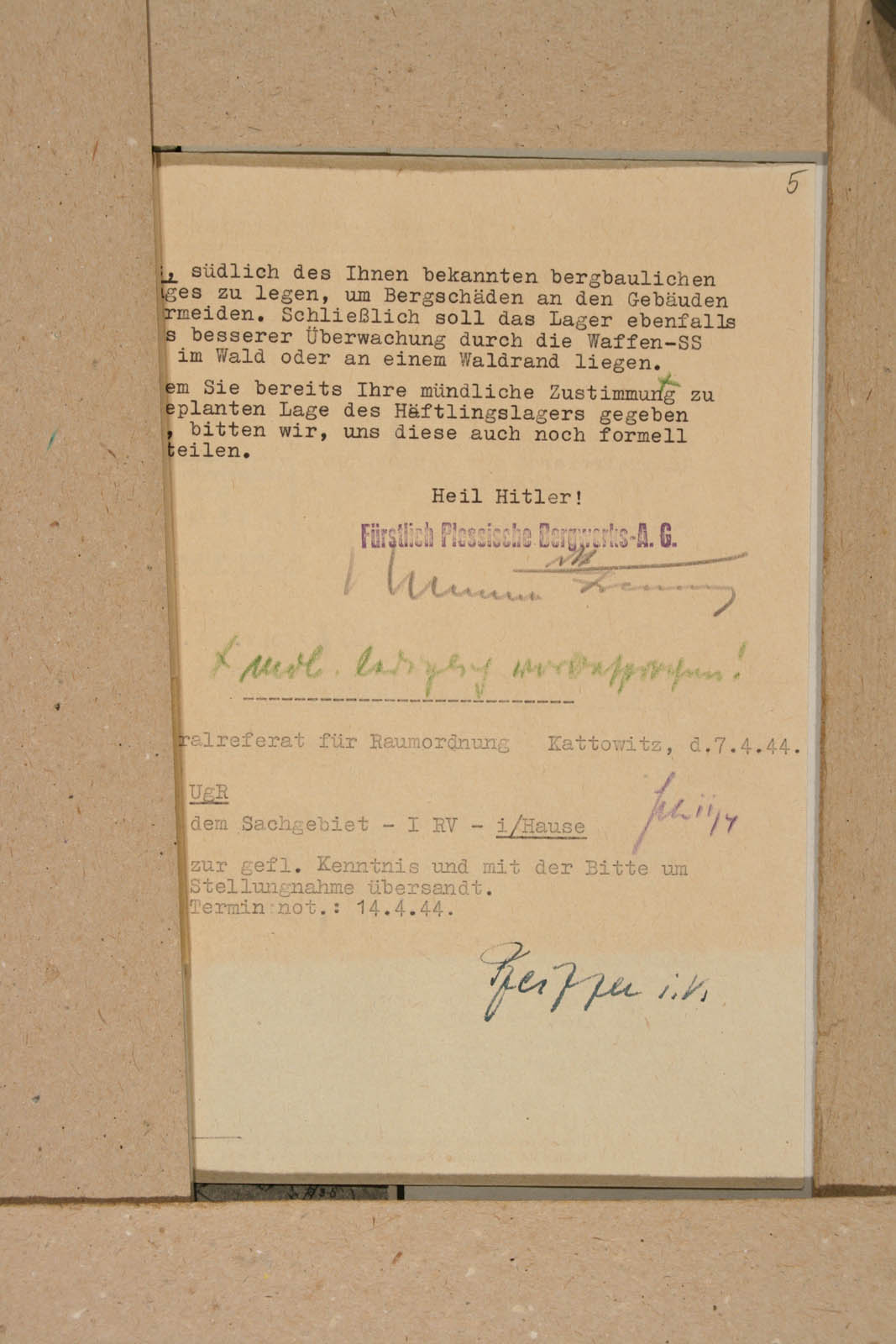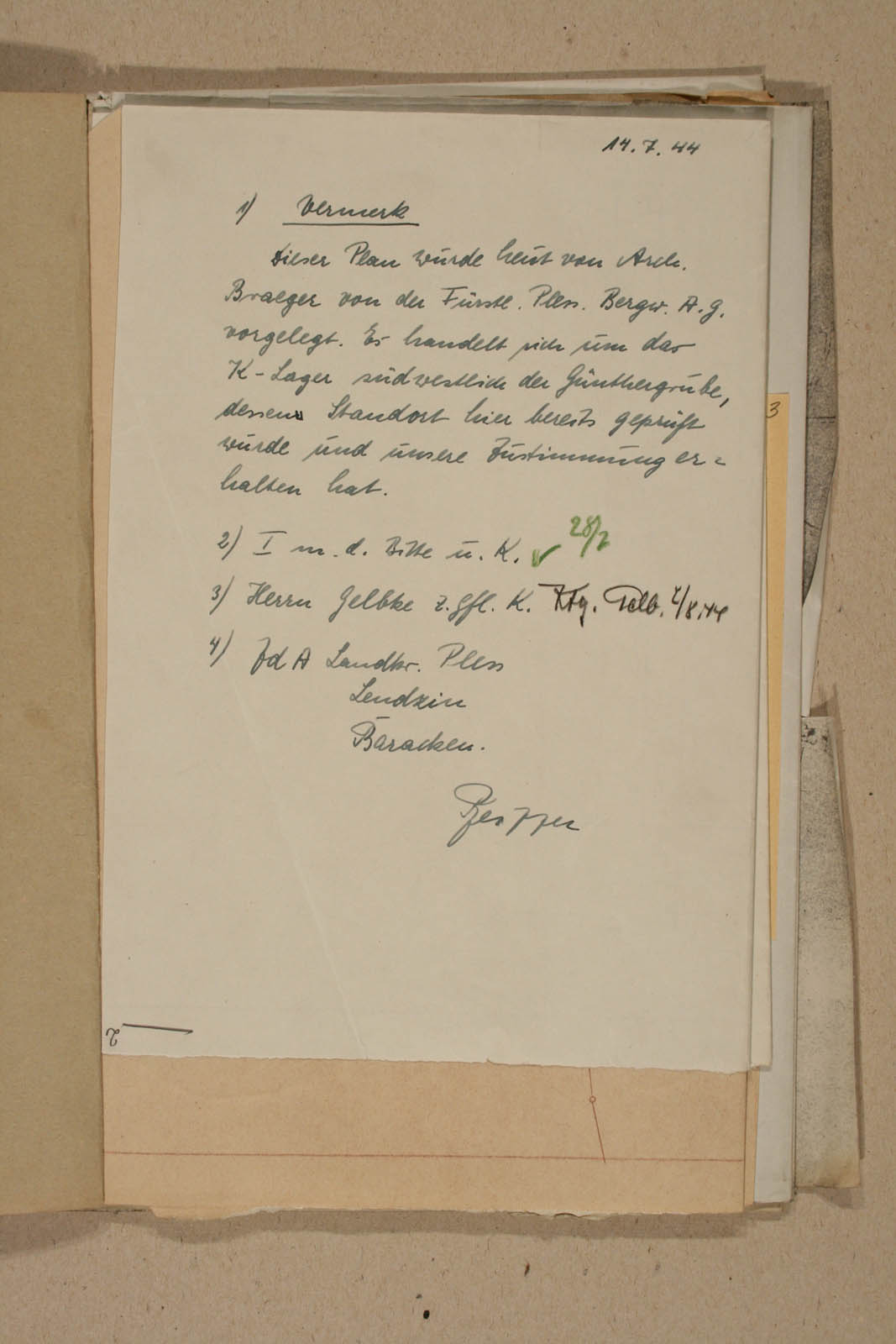Günthergrube
Other Name of the camp
Lager Heimat
Lager Günther III
Commandant of the camp
SS-Oberscharführer Alois Wendelin Frey
Number of SS Guards
Between 20 and 40 SS men from the 3rd Wachkompanie Monowitz.
Work type
Coal Mining: Coal mining in the Piastschächte mine and construction of the Günther mine.
Employer
Fürstliche Plessische Bergwerks AG
Subcontractors:
Schüchtermann und Kremer Bau A.G
Beton-Monteur Bau.
Sub camp buildings
Initially, the prisoners were housed in a forced labour camp, which was located in a school building, on the road to the newly built Günther mine in Lędziny. This camp was called Lager Heimat.
A new camp named Günthergrube was built by the sub camp prisoners.
Number of prisoners
Between 300 to 600 male prisoners. On 17 January 1945 586.
Nationality of prisoners
Mostly Jews from The Netherlands, France, Poland and other countries but also non-Jewish Poles and Germans.
Period of camp existence
1 February 1944 – 18 January 1945
Dissolution / Evacuation of the sub camp
18 January 1945. A group of about 560 prisoners marched on foot in the direction of Gliwice, where they arrived on January 20. A day later the survivors were loaded into open freight cars, but after a few stops the train only got as far as the station Gliwice Rzędówka, just a few kilometres away. Afterwards the surviving prisoners were marched on foot in the direction of Rybnik. During the march there was a commotion caused when one of SS men named Frank, together with the prisoners tried to escape from the column. A shootout ensued, resulting in more than 300 prisoners being killed. The remaining approximately 200 prisoners were probably shot in the stadium in Rybnik
Dates of site visits by Tiergartenstrasse4 Association
June 2006, October 2006 and March 2007.
Memorialisation
At the site of the former Lager Heimat a small memorial was erected in 1964.
Explore more
The History
The history of the companies and the places prisoners worked, the sub camps, the SS guards and memorialisation of the sites.
The History of the Piastschächte Mine
The Piast Mine in Lendzin belonged to the Duke of Pleß. It was mined in the years 1843-1845 under the name Heinrichsfreude. The seams were again mined in 1893. In 1923 the name of the mine was changed to Henryk and three years later to Piast Shaft (during the Nazi occupation – Piastschächte).[1]
[1] Jaros, Jerzy, Słownik historyczny kopalni węgla na ziemiach polskich, Katowice 1984.
The Post War History of the Ziemowit (Formerly Günther) Mine
After the war, the Polish authorities decided to continue the construction of this mine, which on January 1, 1947 was officially included in the list of mines. [1]
In 1949-1952 the partly completed mine was connected to the Piast mine (renamed at that time to Piast-Ziemowit). Part of the Ziemowit mine was, however, still a separate mining unit called Ziemowit II. The merger of the Ziemowit I and Ziemowit II mines occurred in 1952. The mine belonged to the Jaworznicko-Mikołowski Association of Mining Industry, and from 1982 to the Coal Mine Association in Mysłowice. On July 1, 1972, the Piast mine was incorporated into the Ziemowit mine. [2]
From April 1, 1993, the Ziemowit mine was part of Nadwiślańska Spółka Węglowa S.A. in Tychy. However, since 2003 it has been part of Kompania Węglowa S.A. in Katowice.
[1] Jaros, Jerzy, Słownik historyczny kopalni węgla na ziemiach polskich, Katowice 1984.
[2] Jaros, Jerzy, Słownik historyczny kopalni węgla na ziemiach polskich, Katowice 1984.
The Post War History of the Piast (Formerly Piastschächte) Mine
After the war, the name Piast was reinstated. In 1949, the mine was connected to the Ziemowit mine. Currently, this part of the mine is no longer operational. Most of the mine facilities were demolished and the area is being reclaimed. [1]
[1] Jaros, Jerzy, Słownik historyczny kopalni węgla na ziemiach polskich, Katowice 1984.
The History of the Sub Camp Günthergrube
The sub camp Günthergrube in Lędziny was founded in February 1944. It was one of the sub camps of Auschwitz, founded at the initiative of IG Farben. In Lędziny located about 20 km north-west of Oświęcim was the old coal mine Piast belonging to the Fürstlich Plessische Bergwerks AG. In 1942 the company also began construction of a new mine called Günthergrube about 3 miles south of the old mine. Working the old mine and the construction of a new mine required a significant workforce. Therefore, in Lędziny were erected camps for POWs and civilian workers (Lager Wolga Shaft I for Soviet prisoners of war and Jewish forced labourers and towards the end of the war Italians, Lager Eintracht for female forced labourers, and Lager R188 for Soviet prisoners of war). [1] The available labour from these camps was insufficient to provide the necessary coal supplies for the IG Farben plant in Dwory near Oświęcim. Therefore, it was decided to employ prisoners from Auschwitz to supplement the prisoners of war and civilian labourers.[2]
According to the research of Tadeusz Iwaszko from the Auschwitz-Birkenau State Museum the sub camp Günthergrube was created on February 1, 1944. On this day about 300 prisoners, mostly Jews arrived in Lędziny. Initially, the prisoners were housed in a forced labour camp, which was located in a school building, on the road to the newly built Günther mine in Lędziny. This camp was called Lager Heimat. It was of a rectangle shape and was surrounded by a single row of barbed wire hung on concrete posts. In front of the gate to the camp was a small wooden barrack, which served as a guardhouse and store for the SS (map reference 1). Inside the camp were four long wooden barracks which served as: living quarters for prisoners (map references 3 and 4), a dining room for the SS, kitchen, storehouse and the accommodation of the Lagerältester and latrines (map reference 2), and a storehouse for potatoes, a washroom and a latrine (map reference 6).[3]
The prisoners remained in Lager Heimat until June 1944. Most of the prisoners were transferred at this time to the new sub camp Günther III.
Some of the Auschwitz prisoners had built the new camp named Günther III located near the mine of the same name. It was surrounded by a 3-meter high brick wall on top of which was hung barbed wire. In the four corners were brick built guard towers, and outside the wall single man air raid shelters for the guards Inside the camp there were 10 brick barracks which included: a kitchen (map reference 10), a boiler house and washroom (map reference 9), a prisoner hospital (map reference 8), a storage barrack for food (map reference 2) and clothes (map reference 3), 3 prisoner accommodation barracks (map references 4,5 and 6), a barrack for SS men (map reference 1) and a guard house at the entrance to the sub camp (map reference 13). [4]
After the transfer of most of the prisoners to Günther III the number of prisoners was increased to approximately 600. They slept on two-story bunks equipped with mattresses and blankets. The food at this sub camp did not materially differ in quantity and quality with that of the other sub camps of Auschwitz. The food was brought from IG Farben warehouses in Monowice.
In the Günthergrube sub camp were mostly Jews from the Netherlands, France and Poland (from Sosnowiec and Bedzin). There were also a handful of non-Polish Jews and Germans. The German prisoners were the Kapos. [5]
Some prisoners remained in the Lager Heimat after the opening of the new Günther III camp; specifically the prisoners that worked in the Piast mine. [6]
Prisoners from the sub camp Günthergrube were employed in the Piast mine and the newly built coal mine Günthergrube. The prisoners were divided into two work Kommandos. Kommando I was assigned to construction of the Günther mine and also to work in the Piast mine. Kommando II was assigned to the building of the new Günther III camp. [7]
New prisoners were brought to the sub camp by truck and ill and dead prisoners were taken back to Auschwitz on the return journey. [8]
Maria Piacha a local Polish resident worked in the kitchen of the company Beton-Monteur Bau which was building the Günther mine. She gave testimony to the Auschwitz-Birkenau State Museum in 1960 on her relationship with the prisoners of the sub camp, whom she tried to help with cigarettes and food. She was particularly friendly with a 20 year old German political prisoner from Berlin named Miller, “One day in early 1944 I met him and he gave me a card and letter that he wanted me to send to his mother. The women who I worked with in the kitchen saw it. One of them who had a relationship with an SS man reported it to the Bauleiter named Janke who notified the SS man. Shortly before Easter I and two other civilians that were suspected of helping the prisoners were arrested…. For two weeks I was under arrest in the Günthergrube sub camp, in the barrack in the school…. After two weeks came an SS officer from Auschwitz whose name I do not know…. The SS officer threatened me during the interrogation with his pistol and shooting. Then we were transported to Auschwitz-Monowitz on a truck. Together with me were: the prisoner Miller, the two civilians who had been arrested with me and two other prisoners who had been arrested during their attempted escape from the sub camp Fürstengrube. I was brought to the camp Monowitz in the middle of April 1944.” Piacha was released after two weeks but did not go back to work at Beton-Monteur Bau. She did not know what became of Miller. [9]
In May or June 1944 five Polish Jews planned to escape from the Günthergrube sub camp. The plan was discovered and the five prisoners were taken by truck to Auschwitz. After two weeks the five prisoners were brought back to Günthergrube and on the same day after the sentence was read out they were hanged on the roll call area in front of the assembled prisoners of the sub camp. [10] Present at the execution were the Lagerführer, the Lagerarzt, SS-Obersturmführer Josef Fischer and Untersharführer Gehring, Blockführer of the death block in Auschwitz I. [11]
[1] “Dreszcz Mmocji” by Rozmowaz Rafalembula in Lędziny Teraz! 2011 and “Świadko− wie cierpienia i śmierci w Lędzinach 1939−1955” by Rafal Bula.
[2] Iwaszko, Tadeusz, Podobóz Günthergrube [in:] Zeszyty Oświęcimskie [1970] Nr 12.
[3] Iwaszko, Tadeusz, Podobóz Günthergrube [in:] Zeszyty Oświęcimskie [1970] Nr 12.
[4] Iwaszko, Tadeusz, Podobóz Günthergrube [in:] Zeszyty Oświęcimskie [1970] Nr 12.
[5] BA Ludwigsburg B162/9503, p. 90. Testimony of Tadeusz Szymanski.
[6] BA Ludwigsburg B162/9503, p. 58. Testimony of Maria Piecha.
[7] Iwaszko, Tadeusz Das Nebenlager Günthergrube, [in:] Hefte Von Auschwitz [1971] Nr 12, p. 131-138.
[8] BA Ludwigsburg B162/9503, p. 58. Testimony of Maria Piecha.
[9] BA Ludwigsburg B162/9503, p. 57-61. Testimony of Maria Piecha.
[10] BA Ludwigsburg B162/9503, p. 66. Testimony of Jozef Dudziak.
[11] BA Ludwigsburg B162/9503, p. 91. Testimony of Tadeusz Szymanski.
Literature:
Iwaszko, Tadeusz, Das Nebenlager Günthergrube, [in:] Hefte Von Auschwitz [1971] Nr 12, p. 123-144.
Iwaszko, Tadeusz, Podobóz Günthergrube [in:] Zeszyty Oświęcimskie [1970] Nr 12. p. 113-143.
The SS Guard Unit
The guard unit at the sub camp Günthergrube consisted of between 20 and 40 SS men. They also used guard dogs. The Lagerführer was SS-Unterscharführer Wendelin Alois Frey, known as a sadist, beating prisoners for no reason.
SS-Unterscharführer Thomas Stanossek, was remembered by the prisoners as a benevolent man who tried to help them. However, he was unexpectedly arrested in July 1944, and was succeeded by SS-Rottenführer Adam Schepp. [1]
The prisoner hospital in Günthergrube was headed by SS-Obersturmführer Josef Fischer.
[1] Tadeusz, Iwaszko, Das Nebenlager Günthergrube, [in:] Hefte Von Auschwitz [1971] Nr 12, p. 120.
Literature:
Iwaszko, Tadeusz, Podobóz Günthergrube [in:] Zeszyty Oświęcimskie [1970] Nr 12. p. 113-143.
The SS Guards
References:
BA Ludwigsburg B162/2680 and B162/2679.
Zppw-auschwitz.pl Zwiazek Polaków Pomordowanych w Auschwitz. List of 8,500 SS men in KL Auschwitz.
IPN database of Auschwitz SS guards. https://truthaboutcamps.eu/th/form/60,Zaloga-SS-KL-Auschwitz.html.
Iwaszko, Tadeusz, Podobóz Günthergrube [in:] Zeszyty Oświęcimskie [1970] Nr 12. p. 113-143.
The Evacuation of the Sub Camp Günthergrube
The evacuation of sub camp Günthergrube began in December 1944 when a group of Polish prisoners were transported back to Auschwitz III-Birkenau from where they were transported to the Buchenwald concentration camp.
The remaining prisoners were ordered to leave the camp on January 18, 1945. A group of about 560 prisoners marched on foot in the direction of Gliwice, where they arrived on January 20. A day later, the survivors were loaded into open freight cars, but after a few stops the train only got as far as the station Gliwice Rzędówka, just a few kilometres away. There appeared a group of SS men, commanded by SS-Unterscharführer Karl Kurpanika, who ordered the prisoners to remove the bodies of the dead prisoners. Afterwards, the surviving prisoners were marched on foot in the direction of Rybnik. During the march there was a commotion caused when one of SS men named Frank, together with the prisoners tried to escape from the column. A shootout ensued, resulting in more than 300 prisoners being killed. The remaining approximately 200 prisoners were probably shot in the stadium in Rybnik.
Literature:
Iwaszko, Tadeusz, Podobóz Günthergrube [in:] Zeszyty Oświęcimskie [1970] Nr 12. p. 113-143.
The Post War History of the Former Sub Camp Günthergrube
After the war German prisoners of war worked in the Piast and Günther mines, where over 600 died. In which camp (s) they were housed has not yet been determined. When the prisoners were released, a huge employment gap appeared. These gaps were filled by Junaks in the service of Poland, students of the industrial schools and soldiers of the Labour Battalion. [1]
Today on the former sub camp area Lager Günther III is a business premises.
[1] “Dreszcz Mmocji” by Rozmowaz Rafalembula in Lędziny Teraz! 2011 and “Świadko− wie cierpienia i śmierci w Lędzinach 1939−1955” by Rafal Bula.
The Preservation Status of the Former Sub Camp Günthergrube
The remnants of the former Lager Heimat and Lager Günther III can be found in Lędziny about 20 km north-west of Oświęcim.
The Lager Heimat was about half-way along ul Paderewski. There exists a small memorial, but there are no remnants of the original camp.
The former camp Günther III lies on ul Rachowy. There you can see today a large part of the original wall of the camp, a camp gate and a building which was the SS guardhouse. Inside there are numerous remnants of the prisoner barracks. The former sub camp is virtually intact.
Memorialisation
The Lager Heimat was about half-way along ul Paderewski. At the site of the Lager Heimat a small memorial was erected in 1964, but there are no remnants of the original camp. There is no memorial at the site of the Günther III camp.
Auschwitz-Birkenau State Museum Site Visit
We were unable to find any evidence that the Auschwitz-Birkenau State Museum visited the site of the former Günthergrube sub camps or took any photographs.














